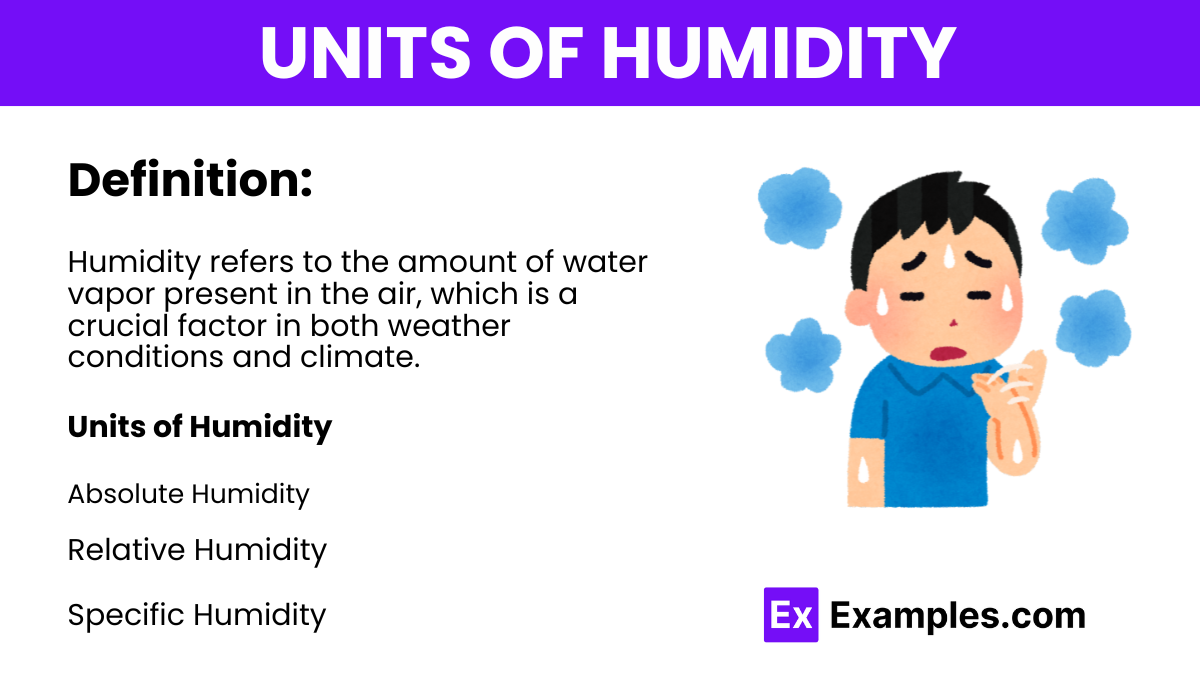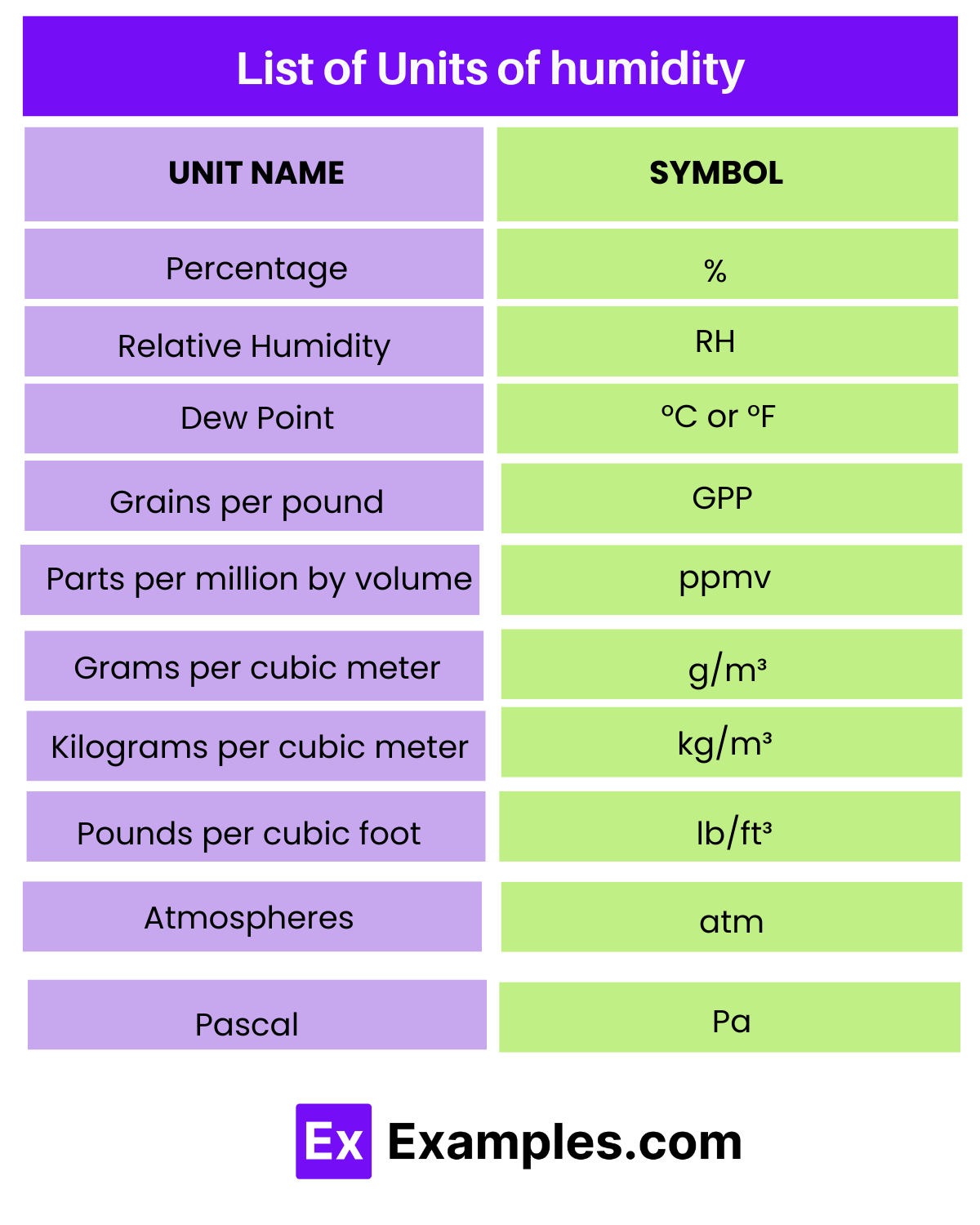What is the most common unit for measuring relative humidity?
Percent (%)
Grams per cubic meter (g/m³)
Degrees Celsius (°C)
Millimeters (mm)


Absolute humidity is the measure of water vapor (moisture) in the air, regardless of temperature. It is expressed as the mass of water vapor present in a given volume of air. The formula for calculating absolute humidity is
The units of humidity vary depending on the type of humidity measurement.
which measures the mass of water vapor present in a certain volume of air.
This unit measures the mass of water vapor present in a specific volume of air, much like its SI counterpart but using cubic centimeters instead of cubic meters.

| Unit Name | Symbol |
|---|---|
| Percentage | % |
| Relative Humidity | RH |
| Dew Point | °C or °F |
| Grains per pound | GPP |
| Parts per million by volume | ppmv |
| Grams per cubic meter | g/m³ |
| Kilograms per cubic meter | kg/m³ |
| Pounds per cubic foot | lb/ft³ |
| Atmospheres | atm |
| Pascal | Pa |
Percentage (%):
Relative Humidity (RH):
Dew Point (°C or °F):
Grains per pound (GPP):
Parts per million by volume (ppmv):
Grams per cubic meter (g/m³):
Kilograms per cubic meter (kg/m³):
Pounds per cubic foot (lb/ft³):
Atmospheres (atm):
Pascal (Pa):
Humidity, the amount of water vapor present in the air, is measured using various instruments called hygrometers. Here are some common methods for measuring humidity:
| Aspect | Absolute Humidity | Relative Humidity |
|---|---|---|
| Definition | Actual amount of water vapor present in the air | Ratio of the amount of water vapor present to the maximum amount the air can hold at a specific temperature and pressure |
| Unit of Measurement | Grams per cubic meter (g/m³) or kilograms per cubic meter (kg/m³) | Percentage (%) |
| Dependency on Temperature | Absolute humidity remains constant regardless of changes in temperature | Relative humidity is influenced by changes in temperature; as temperature increases, relative humidity decreases if absolute humidity remains constant |
| Dependency on Pressure | Absolute humidity remains constant regardless of changes in pressure | Relative humidity remains relatively constant with changes in pressure if absolute humidity and temperature remain constant |
| Saturation Point | No concept of saturation; absolute humidity can increase indefinitely | Relative humidity reaches 100% when the air is fully saturated with water vapor; further moisture addition results in condensation or fog |
| Example | If the absolute humidity is 10 g/m³, it means there are 10 grams of water vapor in every cubic meter of air | If the relative humidity is 50%, it means the air contains 50% of the maximum amount of water vapor it can hold at a given temperature and pressure |
The three measurements of humidity are absolute humidity, relative humidity, and specific humidity. They quantify the amount of water vapor present in the air using different approaches.
High humidity levels typically exceed 60-70% relative humidity. At this level, the air feels sticky and uncomfortable, and there’s an increased risk of mold growth and moisture-related issues.
Text prompt
Add Tone
10 Examples of Public speaking
20 Examples of Gas lighting
What is the most common unit for measuring relative humidity?
Percent (%)
Grams per cubic meter (g/m³)
Degrees Celsius (°C)
Millimeters (mm)
Which instrument is commonly used to measure humidity?
Barometer
Thermometer
Hygrometer
Anemometer
Absolute humidity is measured in which unit?
Percent (%)
Grams per cubic meter (g/m³)
Kilograms per liter (kg/L)
Milligrams per liter (mg/L)
What is the term for the ratio of the partial pressure of water vapor to the equilibrium vapor pressure of water at a given temperature?
Absolute humidity
Specific humidity
Relative humidity
Dew point
Which unit is used to measure the dew point?
Percent (%)
Degrees Celsius (°C)
Grams per cubic meter (g/m³)
Millimeters (mm)
What does a relative humidity of 100% indicate?
The air is completely dry
The air is saturated and can hold no more water vapor
The air is partially saturated
The temperature is at the dew point
Which of the following instruments uses a wet and dry bulb thermometer to measure humidity?
Barometer
Sling psychrometer
Hygrometer
Anemometer
What is the unit for measuring vapor pressure in the context of humidity?
Percent (%)
Grams per cubic meter (g/m³)
Pascals (Pa)
Millimeters (mm)
What does the term "specific humidity" refer to?
The total amount of water vapor in a volume of air
The temperature at which air becomes saturated
The ratio of water vapor to dry air
The mass of water vapor per unit mass of dry air
What does a hygrometer measure?
Temperature
Air pressure
Wind speed
Humidity
Before you leave, take our quick quiz to enhance your learning!

